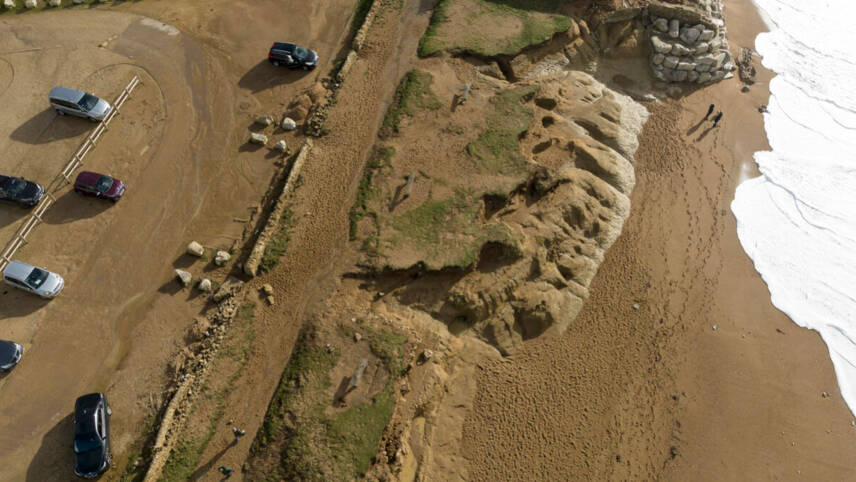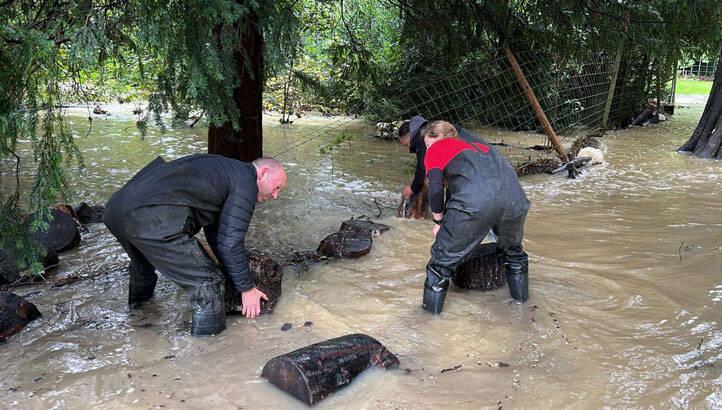Register for free and continue reading
Join our growing army of changemakers and get unlimited access to our premium content

Pictured: Recent storm damage to Hive Beach, Dorset. Image: National Trust & John Miller
The charity, which manages more than 28,000 buildings and some 780 miles of coastline, has stated that seven in ten of the places it cares for will face a medium or high risk of damage from climate-related hazards by 2060.
This finding was reached following an extensive analysis in partnership with GIS Consultants 3Keel. The Trust has stated that changing weather patterns “can play havoc” with every element that it cares for including country land, gardens, parks, beaches, cliffs and historic buildings.
Indeed, this is already happening in some places. Most UK regions experienced drought in the summer of 2022 and, in October 2023, two storms hit the UK.
The National Trust has been dealing with fallen trees and fences, coastal damage and flooding across its estate this winter. Last summer, it has revealed, increased humidity heightened the risk of pests and diseases impacting plants.
According to the Climate Change Committee (CCC), the UK’s average winter temperatures will be 1C warmer in 2050 than at present. Winters will also be 5% wetter and rain will be more likely to come in heavily. Summers, the CCC is predicting, will warm more rapidly and be at least 10% drier. Risks relating to drought will intensify.
The National Trust has set out its own updated plans for adapting to predicted future climate change. Its plans include using improved science-based and place-based evidence to identify and deploy the right solutions in the right places.
Interventions made to date include peatland restoration, tree planting and re-meandering rivers.

Pictured: Flooding at Belton, Lincolnshire, following Storm Babet in October 2023.
Nonetheless, the Trust is warning that it does not have all the answers itself – and will not be able to deliver its plans in full without greater policy support.
It is pushing all major political parties to include a Climate Resilience Act in their manifesto for the upcoming general election. Such an act would build on existing adaptation plans with binding legal targets for climate adaptation, plus clearer allocations of climate resilience duties to government bodies.
The National Trust’s director for the outdoors and natural resources Patrick Begg said: “Our staff are already seeing changes where they work. Climate change isn’t something that is happening abroad, it is happening right here and now.
Patrick added: “Scientific report after scientific report tells us that we must act now to ready ourselves for the very worst impacts of climate change, which is supported by our own property observations. There are also strong economic arguments for investing early in climate adaptation.
“We need greater speed and clarity of thought from our leaders, and a recognition that adapting to climate change is as urgently needed as mitigating the UK’s carbon emissions.”
Funding challenges for flood defences
The news from the National Trust comes days after the National Audit Office (NAO) published a new assessment of the UK Government’s flood risk management plans.
Due to delays and mounting costs, the NAO is concerned that around one-quarter of the 2,000 new flood defence projects first promised for completion by the end of 2027 will not be completed.
These projects were set out by the Environment Agency in 2020 and should cover 336,000 homes. Now, the NAO is concerned that at least 136,000 of these homes will be left at risk.
Inflation has been blamed by the Environment Agency and Department for the Environment, Food and Rural Affairs (Defra).
This is without mentioning the slow start to the flood protection programme amid the Covid-19 pandemic. The NAO has confirmed a £310m underspend between 2020 and 2022 meaning that, to date this decade, the Environment Agency has only completed schemes benefitting 59,000 homes.
“If there are further delays to the capital programme, Defra must work with HM Treasury to make sure it is in a position to switch money quickly into maintenance, where this would provide value for money,” said the head of the NAO Gareth Davies.
“The Environment Agency will have to manage a record level of capital investment in flood defences for the remaining four years of the programme. In doing so, it must resist pressure to accelerate projects or initiate new ones too quickly, if this is likely to lead to cost overruns and delays and put value for money at risk.”
Defra has stated that it will continue to deliver all projects already announced, and will set out more detail on how it will manage programme delivery with pandemic-related delays and inflation taken into consideration.


Please login or Register to leave a comment.